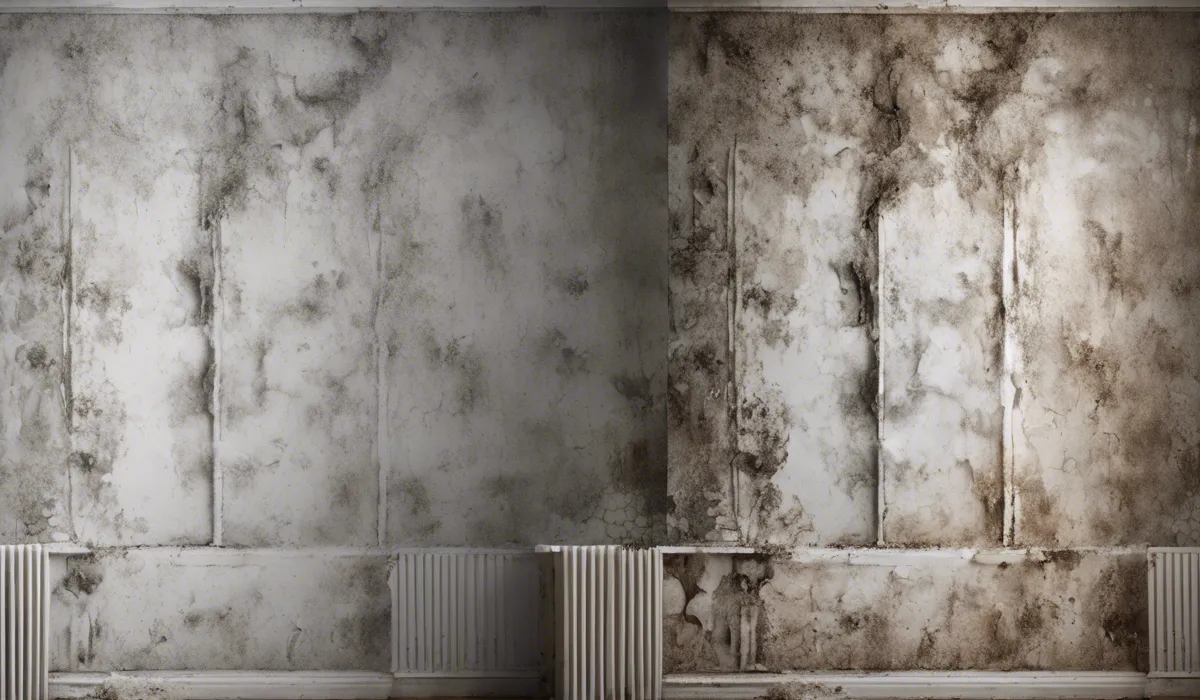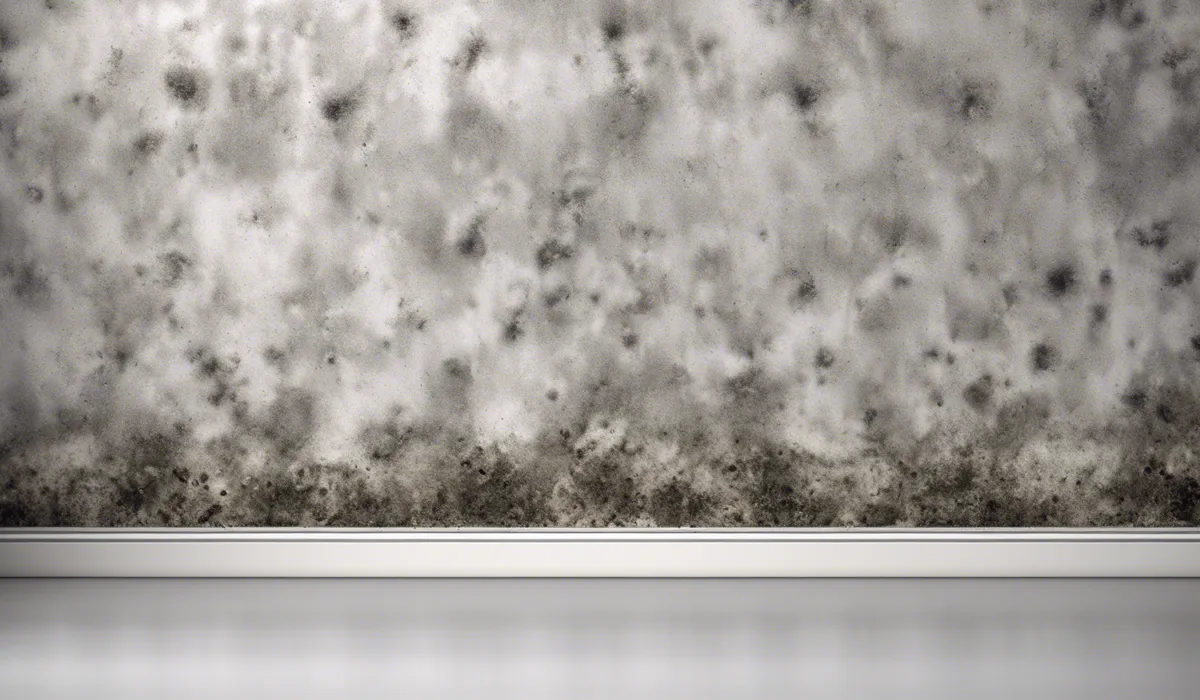Mold can grow in walls within 24-48 hours under ideal conditions. The growth rate depends on moisture levels, temperature, and organic material availability. If conditions remain favorable, mold can spread significantly within 1-2 weeks.
Mold Growth Factors in Walls

Presence of Moisture and Humidity Levels
When it comes to mold growth, moisture is the number one culprit. Mold thrives in damp, humid conditions, making areas with water damage or high humidity prime spots for mold development.
Leaks in plumbing, flooding, or even high humidity can saturate wall cavities, creating an environment where mold can quickly take hold.
It is crucial to keep indoor humidity levels below 60 percent, as higher humidity can support the growth of mold within the walls.
Simple actions like using dehumidifiers or running exhaust fans in bathrooms and kitchens can help maintain optimal humidity levels.
Ambient Temperature and Conditions
Mold generally prefers warm temperatures, typically between 77°F and 86°F. However, some mold species can still grow at temperatures as low as 32°F. This means that even during cooler months, mold can grow if other conditions are favorable.
By maintaining a moderate temperature and addressing any sudden changes that could condense moisture on surfaces, the risk of mold growth in walls is significantly reduced.
Types of Building Materials and Wall Surfaces
Different building materials offer varying degrees of susceptibility to mold growth. Porous materials like wood and drywall absorb moisture easily and can become moldy if they remain wet.
Non-porous surfaces, such as metal or plastic, are less likely to support mold growth but can still accumulate mold if dust and other organic materials are present.
It is essential to choose materials wisely, especially in areas prone to moisture, to prevent mold from taking root in the walls.
Ventilation and Airflow
Good ventilation is crucial for preventing mold growth. Without proper airflow, moisture can accumulate within wall cavities, creating an ideal environment for mold.
Ensuring adequate ventilation, particularly in areas like bathrooms and kitchens where moisture is common, can help to circulate air and remove excess humidity.
This circulation of air also helps to dry out any accidental water intrusion before it can lead to mold growth.
Existing Mold Spores and Cross-Contamination
Mold spores are ubiquitous in the environment, and if they find a suitable spot, they will grow. Cross-contamination occurs when mold spores travel from one area to another, potentially settling in the walls.
This can happen through air currents, on clothing, or with pets. Regular cleaning and use of HEPA filters in HVAC systems can help to minimize the spread of mold spores throughout the home.
Stages of Mold Growth in Walls

Incubation and Initial Colonization
In the initial stage of mold growth, known as incubation, mold spores settle onto surfaces and begin to colonize.
They require moisture, food, and the right temperature to start growing. In the walls, this can happen invisibly, behind wallpaper or paint.
This stage can occur rapidly, with mold beginning to grow within 24 to 48 hours under ideal conditions. Early detection and remediation are essential to prevent further growth.
Mycelium Expansion and Hyphal Growth
As mold continues to grow, the network of filaments, known as mycelium, expands throughout the organic material in the walls. This growth can weaken the structural integrity of wall materials like wood or insulation.
During this stage, mold can become more visible, showing up as spots or streaks on wall surfaces. Ensuring walls remain dry and promptly fixing any water intrusion can stop the mycelium from spreading.
Spore Formation and Dispersal
In the final stage, mold matures and begins to form spores, which are then released into the air to propagate.
This can lead to widespread contamination and can negatively impact indoor air quality and health. To prevent spore dispersal, it is critical to address mold growth as soon as it is detected and before it reaches this advanced stage.
Prevention and Control of Mold in Walls

Regular Maintenance and Inspections for Leaks and Dampness
One of the best ways to prevent mold growth in walls is through regular maintenance and inspections.
Identifying and fixing leaks promptly, ensuring proper sealing around windows and doors, and inspecting roofs and plumbing regularly can prevent water from entering wall cavities.
By staying vigilant and addressing issues quickly, the risk of mold development is greatly reduced.
Proper Ventilation and Humidity Control
Effective ventilation and humidity control are essential in preventing mold in walls. Using exhaust fans, opening windows when weather permits, and using dehumidifiers can help to maintain appropriate humidity levels.
In addition, air conditioners and HVAC systems should be regularly serviced to ensure they are functioning correctly and not contributing to excess moisture.
Use of Mold-Resistant Materials and Paints
When building or renovating, choosing mold-resistant materials can be a proactive step in preventing mold growth in walls.
Materials like mold-resistant drywall or paints containing mold inhibitors can help to repel moisture and prevent mold from taking hold.
These materials are especially useful in high-moisture areas like bathrooms and basements.
FAQs About Mold Growth in Walls
How quickly can mold start growing in walls?
Mold can start growing in walls within 24-48 hours under ideal conditions.
What factors affect the growth rate of mold in walls?
The growth rate of mold in walls is affected by moisture levels, temperature, and the availability of organic material.
How long does it take for mold to spread significantly in walls?
If conditions are favorable, mold can spread significantly within walls in 1-2 weeks.
Can mold grow in walls even with low moisture levels?
Mold growth is less likely with low moisture levels, but it can still occur if there are minimal amounts of moisture present over a prolonged period.
What should be done if mold growth is suspected in walls?
If mold growth is suspected in walls, it is important to assess and remedy the moisture source and clean or remove the affected materials by following appropriate mold remediation procedures.
Final Thoughts
Mold can rapidly colonize walls, starting within 24-48 hours under optimal conditions. The proliferation is contingent on factors such as moisture, warmth, and the presence of organic materials.
Without intervention, mold can become extensively spread throughout walls in a span of just one to two weeks.
